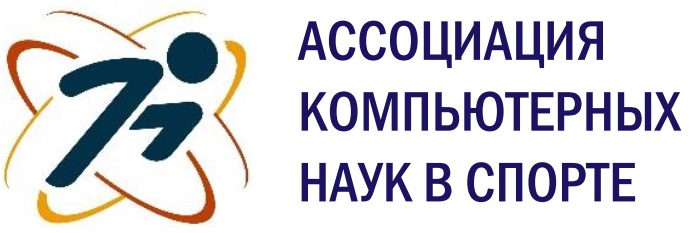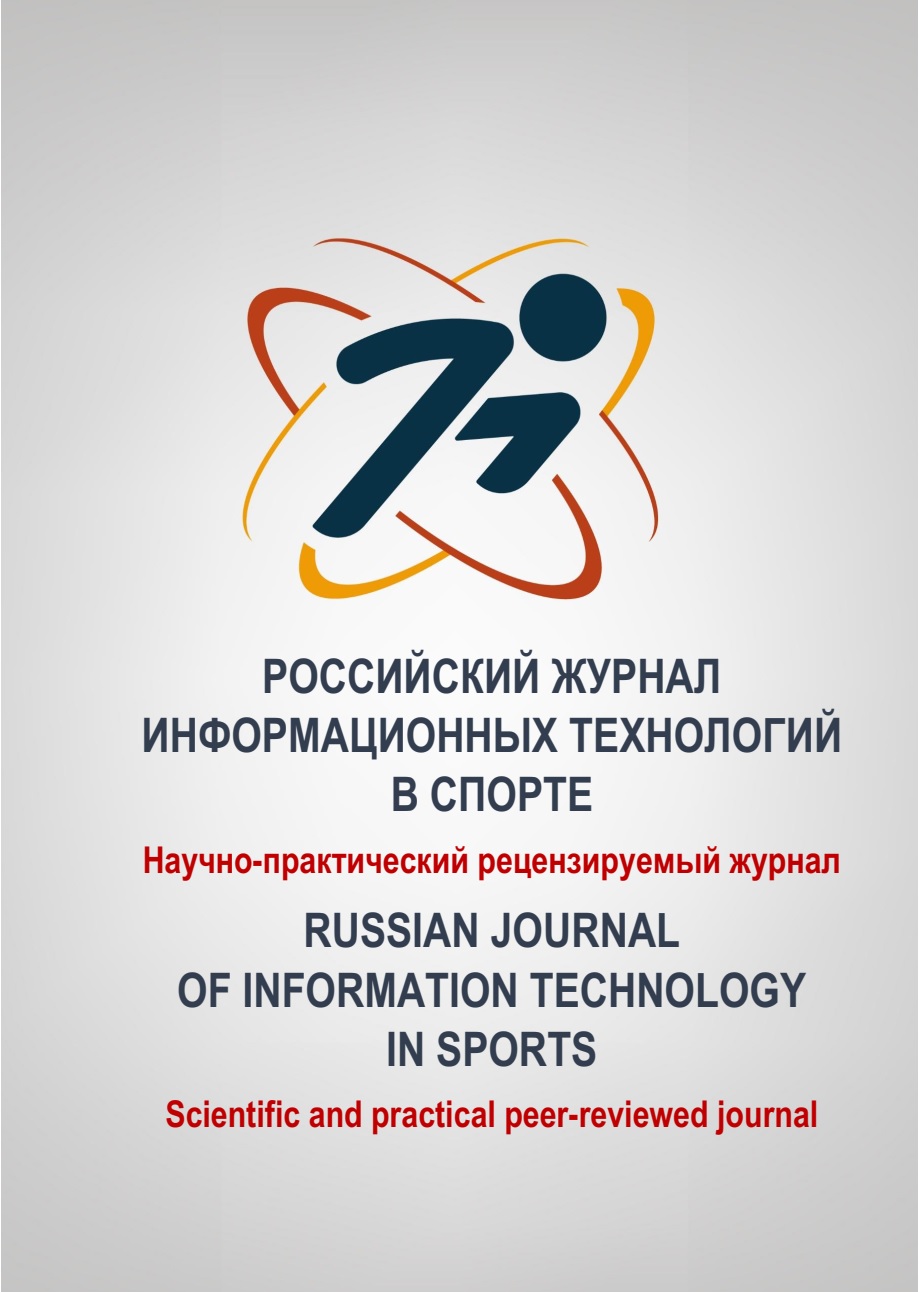Moscow, Russian Federation
Moskva, Moscow, Russian Federation
Russian Federation
Russian Federation
Russian Federation
VAK Russia 1.5.5
VAK Russia 5.8.5
VAK Russia 5.8.6
VAK Russia 2.2.12
UDC 355.233.22
UDC 00
CSCSTI 77.00
CSCSTI 20.00
Russian Classification of Professions by Education 49.00.00
Russian Classification of Professions by Education 06.00.00
Russian Classification of Professions by Education 09.00.00
Russian Library and Bibliographic Classification 28
Russian Library and Bibliographic Classification 3
Russian Library and Bibliographic Classification 75
Russian Trade and Bibliographic Classification 2352
BISAC COM014000 Computer Science
BISAC COM018000 Data Processing
BISAC COM089000 Data Visualization
BISAC COM021000 Databases / General
BISAC COM023000 Educational Software
BISAC COM025000 Expert Systems
BISAC COM074000 Hardware / Mobile Devices
BISAC COM032000 Information Technology
Relevance. Individually oriented training of road cyclists is hampered by the lack of a reliable approach to determining the proper parameters of training work. The objective is to adapt the concept of the full bioenergetic spectrum of physical load (FBES) by Magniy Rodionovich Smirnov as a theoretical, methodological and technological basis for personalized optimization of training effects. Methods. Theoretical analysis of the FBES concept, data from modern sources on sports biochemistry and physiology in terms of aerobic-anaerobic interactions; comparative analysis of FBES and zonal training models; construction of an individual energy profile of a hypothetical athlete based on laboratory and field test data; development of a functional diagram of a digital platform and a module for automated load programming (in the form of a conceptual architecture and a technological model); expert assessment of the practical significance and a pedagogical experiment to verify the developed pedagogical technology. Results. A method for calculating training parameters using a database management system (DBMS) has been developed for integration into a module of a specialized digital platform for programming training sessions. Conclusion. The theoretical and methodological prerequisites and technological solutions for applying the PBES concept in designing the content of classes in the macro- and mesostructure of sports training for highly qualified road cyclists are revealed. The proposed method allows modeling the proper ratio of aerobic and anaerobic loads with individualization by power and duration. The transition zones and switching points of metabolic modes substantiated by M.R. Smirnov were chosen as critically important guidelines in the developed pedagogical technology.
bioenergetic spectrum of physical activity, individual energy profile, maintenance, metabolic regimes, physiological power zones, road cycling, individualization of training, programming of training load
1. Smirnov M.R. Sports Bioenergetics. Novosibirsk: Novosibirsk Book Publishing House, 2003, 304 p. (in Russ.)
2. Magniy Rodionovich Smirnov. CycloWiki. [Electronic resource] URL: Magniy Rodionovich Smirnov (in Russ.) (accessed: 17.04.2025)
3. Kots Ya.M. Sports Physiology. Moscow: Physical Culture and Sport, 1986, 239 p. URL: https://www.nehudlit.ru/books/sportivnaya-fiziologiya.html (in Russ.)
4. Volkov N.I. Biochemistry. Moscow: Physical Culture and Sport, 1986, 381 p. (in Russ.)
5. Matveev L.P. Fundamentals of Sports Training. Moscow: Physical Culture and Sport, 1977, 280 p. (in Russ.)
6. Kindermann W., Simon G., Keul J. The significance of the aerobic-anaerobic transition for the determination of work load intensities during endurance training. European Journal of Applied Physiology and Occupational Physiology, 1979, 42 (1), pp. 25-34. DOI: https://doi.org/10.1007/BF00421101
7. Coyle E.F., Coggan A.R., Hopper M.K., Walters T.J. Determinants of endurance in well-trained cyclists. Journal of Applied Physiology, 1988, 64 (6), pp. 2622–2630. DOI:https://doi.org/10.1152/jappl.1988.64.6.2622
8. Beneke R. Methodological aspects of maximal lactate steady state – implications for performance testing. European Journal of Applied Physiology and Occupational Physiology, 1995, 70 (1), pp. 225-230. DOI: https://doi.org/10.1007/s00421-002-0783-1
9. Morton R.H., Billat V. Maximal endurance time at VO2max. Medicine and Science in Sports and Exercise, 2000, 32 (8), pp. 1496-1504. DOI: https://doi.org/10.1097/00005768-200008000-00020
10. Luc´ıa A., Hoyos J., Chicharro J.L. Physiology of professional road cycling. Sports Medicine, 2001, 31 (5), pp. 325-337. DOI: https://doi.org/10.2165/00007256-200131050-00004
11. Seiler S. What is best practice for training intensity and duration distribution in endurance athletes? International Journal of Sports Physiology and Performance, 2010, 5 (3), pp. 276-291. DOI: https://doi.org/10.1123/ijspp.5.3.276
12. Wasserman K., Hansen J.E., Sue D.Y., Stringer W.W., Whipp B.J. Principles of Exercise Testing and Interpretation: Including Pathophysiology and Clinical Applications. 5th ed. Philadelphia, PA: Lippincott Williams & Wilkins, 2011, 576 p.
13. Allen H., Cheung S. Cutting-edge cycling. Human Kinetics, 2012, 283 p. ISBN: 9780736091091 URL: https://us.humankinetics.com/products/cutting-edge-cycling
14. Friel J. The Cyclist’s Training Bible. 5th ed. Boulder, CO: VeloPress, 2018, 675 p. ISBN: 9781937715823 URL: https://joefrieltraining.com/book/the-cyclists-training-bible-5th-ed/
15. Allen H., Coggan A.R. Training and Racing with a Power Meter. 3rd ed. Boulder, CO: VeloPress, 2019, 384 p.
16. Myers C., Allen H. Triathlon Training with Power. Cognella Press, 2021, 518 p. URL: https://scientifictriathlon.com/tts305/
17. Pinot J., Grappe F. The record power profile to assess performance in elite cyclists. International Journal of Sports Medicine, 2011, 32 (11), pp. 839-844. DOI: https://doi.org/10.1055/s-0031-1279773
18. Smirnov M.R. Scientifically based number of repetitions of running load segments. Theory and Practice of Physical Culture, 1996, (2), pp. 44-49. (in Russ.) URL: http://lib.sportedu.ru/Press/TPFK/1996N2/p44-49.htm















